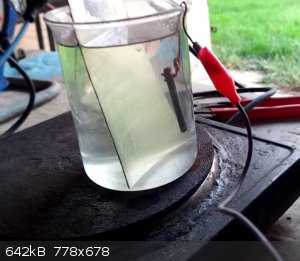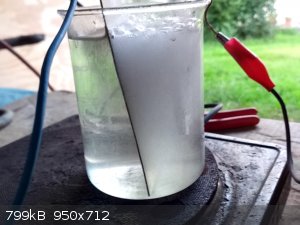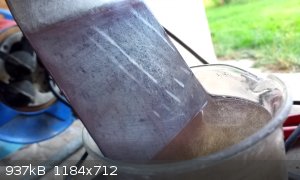TriiodideFrog
Hazard to Others
  
Posts: 108
Registered: 27-9-2020
Member Is Offline
|
|
How to make manganese dioxide electrodes
Does anyone know how to make manganese dioxide electrodes from manganese dioxide? Thanks in advance
|
|
|
Sulaiman
International Hazard
    
Posts: 3782
Registered: 8-2-2015
Member Is Offline
|
|
You can search like this https://www.google.com/search?safe=active&sxsrf=ALeKk01n...
CAUTION : Hobby Chemist, not Professional or even Amateur
|
|
|
mysteriusbhoice
Hazard to Others
  
Posts: 477
Registered: 27-1-2016
Member Is Offline
Mood: Became chemistry catboy Vtuber Nyaa
|
|
you need manganese nitrate which u can start all the way from MnO2 from batteries.
dissolve in HCl and filter.
then dry and bake at 400 Celsius so only MnCl2 survives
react with baking soda to make MnCO3 and then react that with nitric acid.
|
|
|
DraconicAcid
International Hazard
    
Posts: 4413
Registered: 1-2-2013
Location: The tiniest college campus ever....
Member Is Offline
Mood: Semi-victorious.
|
|
I sMnO2 really conductive enough to make electrodes out of it?
Please remember: "Filtrate" is not a verb.
Write up your lab reports the way your instructor wants them, not the way your ex-instructor wants them.
|
|
|
B(a)P
International Hazard
    
Posts: 1139
Registered: 29-9-2019
Member Is Offline
Mood: Festive
|
|
I have tried it and it works, kind of. You wouldn't want to be making a kg of chlorate, but for very small scale and low amperage it does work. I gave
up in frustration at the low rate of conversion from chloride to chlorate and the high erosion rate of the electrode. I also ended up with plenty of
permanganate forming in the electrolyte. It was a fun experiment, but will not give you useful quantities of chlorate if that is what you are after in
my experience. I have read that others have had success though so maybe it is just me. I pretty much followed this Nurdrage video exactly.
I didn't ever try it for HHO if that is what you are after. Best of luck!
https://www.youtube.com/watch?v=BjKYiu8eKa8
|
|
|
j_sum1
Administrator
       
Posts: 6374
Registered: 4-10-2014
Location: At home
Member Is Offline
Mood: Most of the ducks are in a row
|
|
Just be aware that you will produce a lot of chlorine gas doing this. With HCl it is a great foaming mess frothing out of your beaker as well as
giving off chlorine.
You don't want any surprises.
|
|
|
mysteriusbhoice
Hazard to Others
  
Posts: 477
Registered: 27-1-2016
Member Is Offline
Mood: Became chemistry catboy Vtuber Nyaa
|
|
overall for chlorate vacuum epoxy resin impregnated graphite doesnt errode and is a good as EDM graphite and lasts really long!
|
|
|
yobbo II
National Hazard
   
Posts: 777
Registered: 28-3-2016
Member Is Offline
Mood: No Mood
|
|
See attached.
These anodes last a long time and will make kg of stuff
Wont make perchlorate
Yob
Attachment: MnO2 Anodes.pdf (121kB)
This file has been downloaded 833 times
|
|
|
BAV Chem
Harmless

Posts: 29
Registered: 9-5-2021
Location: Irgendwo im nirgendwo
Member Is Offline
Mood: Thoroughly confused
|
|
MnO2 keeps flaking
I have already attempted making a working MnO2 on Ti (Grade 5) electrode twice now. However the coating just comes off after something like a day of
runtime at not even full current density (like 25mA/cm^2).
Is this because I'm using GR5 instead of the recommended GR1?
I've already tried drying the Mn(NO3)2 on the Ti surface before decomposing it but it didn't seem to make a difference.
My plating solution doesn't seem to be bad or anything as it looks pretty pure and the electrodes don't passivate, they just fall apart within a few
days.
|
|
|
markx
National Hazard
   
Posts: 650
Registered: 7-8-2003
Location: Northern kingdom
Member Is Offline
Mood: Very Jolly
|
|
Yup....GR5 is alloyed and no good for electrochemical applications under anodic potentials. I've had it develop pitting and dissolve into the
perchlorate cell liqour, creating a rather spectacular mess of precipitate. I had made the anode stem from GR5 Ti and it was unstable under anodic
conditions in chloride/chlorate bearing electrolyte. It seems the alloying elements prevent it from forming a tough enough oxide coat on the surface.
Good for mechanical applications, but not under extremes of the positive side of a cell.
With GR1 zero problems...it passivates completely and is stable. So always use the GR1 (CP commercially pure) grade of titanium for electrochemical
purposes. Not to mention GR1 is a breeze to machine and tap compared to the alloyed grades that tend to be tough as a coffin nail.
Exact science is a figment of imagination.......
|
|
|
BAV Chem
Harmless

Posts: 29
Registered: 9-5-2021
Location: Irgendwo im nirgendwo
Member Is Offline
Mood: Thoroughly confused
|
|
Alright, thanks. I guess I'm gonna get some GR1 titanium and try again.
|
|
|
yobbo II
National Hazard
   
Posts: 777
Registered: 28-3-2016
Member Is Offline
Mood: No Mood
|
|
Grade one, two, three or four will be OK.
Grade 11 if you want to go as far from getto as possible.
Yob
|
|
|
BAV Chem
Harmless

Posts: 29
Registered: 9-5-2021
Location: Irgendwo im nirgendwo
Member Is Offline
Mood: Thoroughly confused
|
|
Electrochemical etching of titanium using oxalic acid
Normally Ti is etched using HCl before depositing the MnO2. However this method does use a lot of concentrated HCl and handles a lot of
nasty boiling acid.
Now, there's a way of etching Ti, that does not use HCl. Instead the Ti is submerged in boiling oxalic acid solution (mine was about 15%) and
connected up to the negative (yes, the negative) lead of a power supply (in this case 10V but that might not be optimal). The positive is connected to
a graphite rod, also suspended in the solution.
The solution begins to bubble and boil vigorously at the relatively small anode while the titanium cathode starts producing hydrogen and the solution
turns yellow on the surface of the titanium. After a while (like 2min in this
case) electricity is disconnected and the titanium is boiled for another few minutes. Apparrently the cathodic conditions reduce the titanium's
passivation layer and expose the bare metal, essentially activating it and allowing it to react with the acid. on the surface of the titanium. After a while (like 2min in this
case) electricity is disconnected and the titanium is boiled for another few minutes. Apparrently the cathodic conditions reduce the titanium's
passivation layer and expose the bare metal, essentially activating it and allowing it to react with the acid.
I also tried hooking things up the other way round but that only resulted in some really gay looking rainbowy titanium (no offence intended).
Now, is this process any useful? It certainly is to me so I can conserve my HCl a bit and the etching bath is easier to store. Though I should add
that this process produces an oxalic acid aerosol, which is a bit harsh to breathe, so it's still not ideal.
Note: In the picture(s) the copper wire is also in the solution and I got away with it but it's definitely something to avoid. You can see a bit of a
redish deposition of copper (oops) on the etched Ti but that was easily wiped off and the electrode turned out fine.
  
[Edited on 1-8-2021 by BAV Chem]
|
|
|
mysteriusbhoice
Hazard to Others
  
Posts: 477
Registered: 27-1-2016
Member Is Offline
Mood: Became chemistry catboy Vtuber Nyaa
|
|
Quote: Originally posted by BAV Chem  | Normally Ti is etched using HCl before depositing the MnO2. However this method does use a lot of concentrated HCl and handles a lot of
nasty boiling acid.
Now, there's a way of etching Ti, that does not use HCl. Instead the Ti is submerged in boiling oxalic acid solution (mine was about 15%) and
connected up to the negative (yes, the negative) lead of a power supply (in this case 10V but that might not be optimal). The positive is connected to
a graphite rod, also suspended in the solution.
The solution begins to bubble and boil vigorously at the relatively small anode while the titanium cathode starts producing hydrogen and the solution
turns yellow on the surface of the titanium. After a while (like 2min in this
case) electricity is disconnected and the titanium is boiled for another few minutes. Apparrently the cathodic conditions reduce the titanium's
passivation layer and expose the bare metal, essentially activating it and allowing it to react with the acid. on the surface of the titanium. After a while (like 2min in this
case) electricity is disconnected and the titanium is boiled for another few minutes. Apparrently the cathodic conditions reduce the titanium's
passivation layer and expose the bare metal, essentially activating it and allowing it to react with the acid.
I also tried hooking things up the other way round but that only resulted in some really gay looking rainbowy titanium (no offence intended).
Now, is this process any useful? It certainly is to me so I can conserve my HCl a bit and the etching bath is easier to store. Though I should add
that this process produces an oxalic acid aerosol, which is a bit harsh to breathe, so it's still not ideal.
Note: In the picture(s) the copper wire is also in the solution and I got away with it but it's definitely something to avoid. You can see a bit of a
redish deposition of copper (oops) on the etched Ti but that was easily wiped off and the electrode turned out fine.
[Edited on 1-8-2021 by BAV Chem] |
why the cathode is connected up to the Ti instead of it being used as the anode at lower voltages/current density.
isnt the goal to generate some oxide so the oxalic can attack it.
|
|
|
BAV Chem
Harmless

Posts: 29
Registered: 9-5-2021
Location: Irgendwo im nirgendwo
Member Is Offline
Mood: Thoroughly confused
|
|
That's exactly what I thought too but running any current through it with it as the anode only resulted in some pretty colors and even more
passivation. Seems like the oxalic acid is really slow at dissolving Ti oxides. Even some papers state that the etching process in boiling oxalic acid
(no electrolysis) takes something like 12h.
|
|
|
mysteriusbhoice
Hazard to Others
  
Posts: 477
Registered: 27-1-2016
Member Is Offline
Mood: Became chemistry catboy Vtuber Nyaa
|
|
Quote: Originally posted by BAV Chem  | | That's exactly what I thought too but running any current through it with it as the anode only resulted in some pretty colors and even more
passivation. Seems like the oxalic acid is really slow at dissolving Ti oxides. Even some papers state that the etching process in boiling oxalic acid
(no electrolysis) takes something like 12h. |
thats what happens if you run at high overpotential you need to like anodically etch it at around 1.8 volts or something.
|
|
|
BAV Chem
Harmless

Posts: 29
Registered: 9-5-2021
Location: Irgendwo im nirgendwo
Member Is Offline
Mood: Thoroughly confused
|
|
I guess I'm gonna give that a go the next time i make an anode.
|
|
|